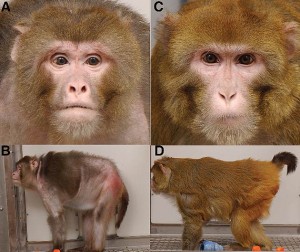Sirt-1, Middle Age Aches, and Arthritis
You may have never heard about the SIRT-1 gene, but you’ve likely seen stories about primate life extension. These are the monkeys who have been fed much less than normal to allow them to live longer and it’s the SIRT-1 gene that makes that happen. If you look at the monkey on the left above, he’s the same age as the money on the right. The one on the right was fed 20% fewer calories, which turned on his SIRT-1 gene and made his muscles better, his hair look young, and kept his joints supple. The one on the left was overfed like most of us and since his SIRT-1 gene was not activated he’s a pre-diabetic couch potato. SIRT-1 is also activated by the resveratrol in red wine, which may also explain why people who drink red wine likely live longer with less heart disease. A few months ago, I noticed that I was starting to get more and more middle aged joint aches (and starting to look like the monkey on the left). Every U.S. citizen past 40 knows these generalized low level pains like an unwelcome house guest. They’re usually present with climbing stairs or when you first get moving after sitting. What do these aches and pains have to do with SIRT-1? Well Joe Maroon told me many years ago that I needed to be taking Resveratrol as it activated the SIRT-1 gene and that this would not only likely help me live longer, but also help control my blood sugar and prevent my diabetic genes from heading down the nefarious, diabetic route 101. Not wanting to starve myself like the monkey on the right (which activates the SIRT-1 gene), I decided to take his advice, more out of concern that my body was firmly shifting into “middle aged” gear. What happened was surprising. Within 1-2 weeks my aches and pains went away and I increased my work-outs by about 20% simply on the basis that it was easier to move. Now a study comes out that shows there may be another reason why my joints stopped hurting: turns out the SIRT-1 receptor is expressed on cartilage cells to keep them healthy. As we age, this gene gets stimulated less and less, which then results in the cartilage cells becoming less stable and prompts them to produce less of the chemicals that help to absorb pressure, likely leading to osteoarthritis. What’s also fascinating is that the SIRT-1 gene activation is also lessened by diabetes and insulin signaling, so that diabetics and patients with syndrome X have shorter life spans and more knee arthritis. The upshot? If you have the early stages of arthritis, take your resveratrol, watch the sugar, and the middle aged aches should disappear!

NOTE: This blog post provides general information to help the reader better understand regenerative medicine, musculoskeletal health, and related subjects. All content provided in this blog, website, or any linked materials, including text, graphics, images, patient profiles, outcomes, and information, are not intended and should not be considered or used as a substitute for medical advice, diagnosis, or treatment. Please always consult with a professional and certified healthcare provider to discuss if a treatment is right for you.

